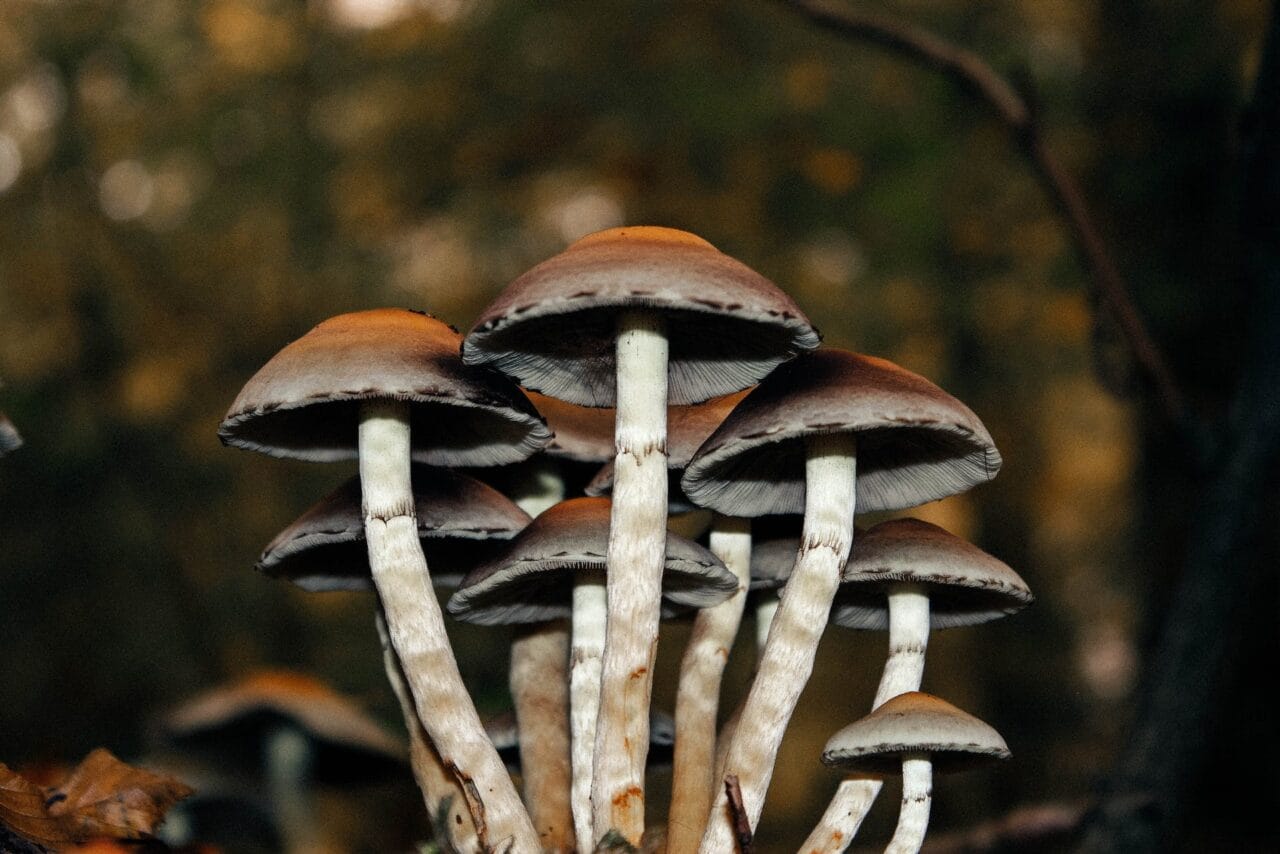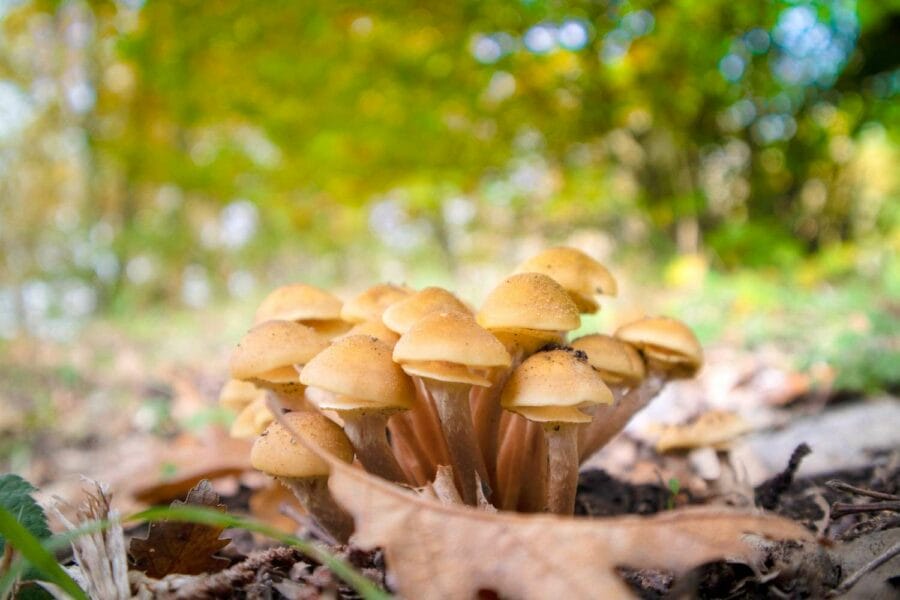Psilocybin, a psychoactive substance found in magic mushrooms, is often used recreationally to induce feelings of euphoria and hallucinations.
In addition to its mind-altering properties, research has also been conducted into the compound’s potential benefits for chronic pain management.
This article delves into a case study that investigates the potential of microdosing mushrooms in providing relief from chronic pain.
Key Takeaways:
- Microdosing mushrooms may provide both immediate and sustained pain relief.
- In contrast to traditional pain medications, psilocybin microdosing generally has no side effects when given in small quantities.
- Psilocybin interacts with the serotonin 2A (5-HT2A) receptors, helping to alleviate pain among other conditions.

The Study
The research, “Microdosing Psilocybin for Chronic Pain: A Case Series“, led by Dr. Matthew Lyes and his team from the Division of Pain Medicine in the Department of Anesthesiology at the University of California, San Diego, centered on three patients who self-administered small doses of psilocybin to manage their chronic pain symptoms.
Three Patients, One Result – Reduction of Chronic Pain
Patient # 1
| AGE/ SEX: | 37 Male |
| KIND OF PAIN: | Neuropathic pain occurring below the site of a spinal cord injury. |
| PAIN INTENSITY: | Initially 4 to 5/ 10, increasing to 8/ 10 later in the day |
| PSILOCYBIN DOSE: | 250 mg of ground mushroom for less than 6 months |
| OUTCOME: | Discontinuation of prescribed pain medication, decrease in muscle spasms, and improvement in bowel movement efficiency. No signs of rebound pain or withdrawal symptoms. |
| The patient reported that while his regular medications only managed to dull the pain, psilocybin effectively silenced it, reducing his average pain level from 5 to 0. | |
Case Study: Subject #2
| AGE/ SEX: | Female, 69 years old |
| PAIN TYPE: | Complex Regional Pain Syndrome (CRPS) |
| PAIN INTENSITY: | Typically between 5 and 7 out of 10, but increases with physical activity and during pain flare-ups |
| PSILOCYBIN DOSAGE: | Regular consumption of 500 mg daily for a week to ten days, interspersed with 2 to 3 day breaks over a year. During pain flare-ups, the dosage increases to 750 mg to 1 gram |
| EFFECT: | Pain decreases by 80% for 3-4 hours, then slowly returns to original levels after 12 hours. Complete pain relief (90%-100%) persists for 6-8 hours, then returns to original levels after 18 hours. |
| The subject reports a loss of appetite without experiencing nausea. A disorientation or imbalance in walking is observed when the dosage increases to 750 to 1000mg. | |
Case Study: Subject # 3
| AGE/ SEX: | Female, 40 years old |
| PAIN TYPE: | Lumbar radiculopathy and neuropathic pain |
| PAIN INTENSITY: | 8 out of 10, increasing to 10 out of 10 during physical activity |
| PSILOCYBIN DOSAGE: | 1000 mg from a mushroom-infused chocolate bar every two months. |
| EFFECT: | Significant alleviation of pain without any psychoactive effects. An improvement in flexibility and functionality is noted. Pain gradually returns to baseline levels over a 2-4 week period. Regular dosing improves pain management. |
| The subject does not report any significant physical, cognitive, or behavioural side effects. Her mood remains generally stable. She continues with her normal dosage of SSRI for depression management during the psilocybin treatment phase. | |
Exploring Pain Management through Psilocybin
Chronic physical and visceral pain can create and reinforce certain neural pathways due to peripheral and central sensitization, resulting in persistent physical and emotional pain experiences. Psychedelic substances like psilocybin stimulate 5-HT2A receptors, possibly resetting brain areas associated with neuropathic conditions.
A patient reported experiencing pain relief for several weeks. This suggests that directly stimulating the 5-HT2A receptors may lead to a central regulation of pain perception and adaptability in the synapses.
Potential Side Effects of Psilocybin Vs. Traditional Pain Relievers
| PSILOCYBIN (Research-Based) | TRADITIONAL PAIN RELIEVERS |
| Muscle spasms | Nausea |
| Decreased appetite | Discomfort in the abdomen |
| Bewilderment | Headaches |
| Unsteady gait | Dependency |
| Absence of mood changes | Drowsiness |
Future Research Possibilities for Psilocybin
The research team, following their analysis of three participants’ experiences, has highlighted certain areas that could benefit from further investigation due to their potential benefits.
- Small quantities of psilocybin might provide instant and possibly long-lasting relief from neuropathic pain without leading to physical tolerance or dependence.
- Explore the outcomes of different treatment methods when combined with psilocybin. For example, patient #3 reported an increased pain-relieving effect when psilocybin was used in conjunction with physical therapy.
- Even in the absence of psychotherapy, small doses of psilocybin may deliver pain relief, as demonstrated by this case study. The investigators suggest that merging therapeutic supervision could potentially enhance or extend the therapeutic effects.
Study Limitations
Despite the encouraging findings in the patients, it’s crucial to acknowledge the study’s recognized limitations.
- The small number of subjects might not be a comprehensive representation of all individuals dealing with neuropathic pain.
- The study did not consider subjects who did not respond to psilocybin.
- No assessments were conducted before and after treatment to evaluate the impact of psilocybin on psychiatric issues such as depression and anxiety.
- Most of the data was self-reported by the participants.
- The interviewer’s presence and potential biases related to psilocybin could have influenced the participants’ responses.
- The study did not investigate the influence of the placebo effect.
- The study did not ascertain the quantity of psilocybin in each mushroom.
Microdosing Psilocybin Mushrooms
Patient #1 and #2 in this research took a microdose of psilocybin in powdered form, originating from dried mushrooms, whereas patient #3 combined it with chocolate. A variety of products are tailored for psilocybin microdosing, some of which are listed below.
Dried Mushrooms
Even though the specific strain used in the study was not mentioned, the following strain is recommended for those new to this practice.
- Golden Teacher: This is one of the most prevalent and widely recognized strains of magic mushrooms.
- Amazonian Cubensis: Renowned for being beginner-friendly and potentially providing cognitive enhancements.
- Cambodian: Microdosing with Cambodian cubensis mushrooms may improve focus, social awareness, and mood.
Microdose Capsules
- Euphoria Psychedelics – Micro Calm Capsules: This concoction contains Ashwagandha, Reishi, CBD, Valerian root, and Psilocybin Mushrooms, all of which have been scientifically shown to alleviate anxiety and stress.
- Ground Sounds – Microdose Capsules – Champion Lover: This captivating blend offers three dosage levels: 50mg, 100mg, or 250mg of pure psilocybin combined with reishi, cacao, cordyceps, and maca.
- Kind Stranger – Brighten Capsules 250mg: These capsules feature the Golden Teacher strain, reputed for fostering clear thinking, heightened creativity, and improved concentration.
Pain Reduction with Psilocybin
While research on the analgesic properties of mushrooms is still in its preliminary stage, anecdotal reports and minor case studies offer promising signs.
These instances underscore the importance of more comprehensive research into the potential benefits of psilocybin, class=”wp-block-list”>
Especially in the field of chronic pain management.
Before the widespread acceptance of psilocybin in pain relief, the promising narratives from the case study foster hope for those enduring chronic pain.
Frequently Asked Questions
What effects does psilocybin microdosing have?
Psilocybin mainly stimulates a serotonin receptor known as “5-HT2A” in the prefrontal cortex, leading to two primary outcomes:
- Generation of “Brain-Derived Neurotrophic Factor” (BDNF)
- Enhanced “Glutamate” transmission
Moreover, psychedelics foster links between brain areas that don’t usually interact. This distinctive connectivity is an effect of psychedelics’ ability to diminish the activity of the “Default Mode Network” (DMN), which is linked to several cognitive functions, such as daydreaming, introspection, and reflecting on the past and future.
What is the most recognized benefit of microdosing mushrooms?
Microdosing may enhance mood, productivity, creativity, and focus. Its most extensively researched benefit is its influence on mental health.
In November 2022, COMPASS Pathways, a mental health company, unveiled the findings of their comprehensive phase 2b trial, a randomized and double-blind study. Their investigation indicated that a single dose of psilocybin resulted in considerable reductions in depressive symptoms compared to a placebo. Participants who received a higher dose of 25 milligrams showed a maintained antidepressant response at the twelve-week follow-up.
The Psychiatry Research Journal published a study reporting that psilocybin is more effective than traditional antidepressant treatments.
How can you determine your dosage?
Start with a 0.1-gram dose of psilocybin mushrooms on the first day. If the expected results are not seen, you can incrementally increase your dose by 0.05 grams on subsequent microdosing days until you reach your ideal level.
Individuals with a history of psychotropic drug use may need to elevate the dosage to 0.5 grams to attain the desired effects.
What should be done before consuming mushrooms?
- Allocate some time to understand the reasons for your microdosing on any given day.
- Set aside a moment for self-reflection and connection with your current emotional or mental state. Identify the sentiments or mindset that you believe will be advantageous for you throughout the day.
- Once your goals are clearly set, record them. Formulating your objectives as affirmations can serve as a potent instrument for your ongoing growth.
- Direct your intention towards the experience you wish to attain, rather than what you aim to avoid.
- Take it on an empty stomach, preferably an hour before your first meal of the day.
What frequency is advised for the consumption of microdoses of mushrooms?
A number of well-regarded protocols propose structured microdosing schedules for psychedelics. The primary difference in these protocols lies in the number of “off” days included, which are the days you abstain from microdosing.
The most commonly suggested protocols advocate for incorporating 1-3 rest days between microdoses. This aligns with the body’s natural tolerance mechanisms. The three protocols being considered in this context are the Fadiman Protocol, the Stamets Stack, and intuitive microdosing.




